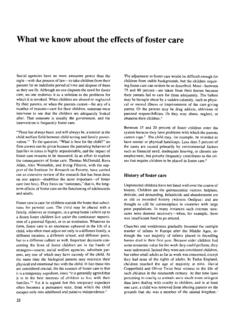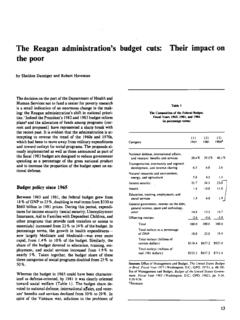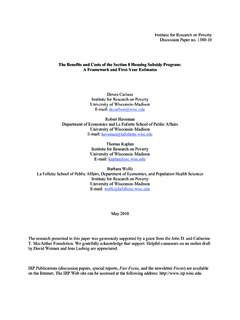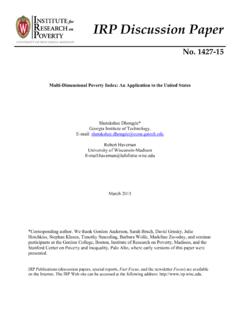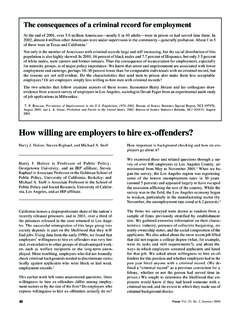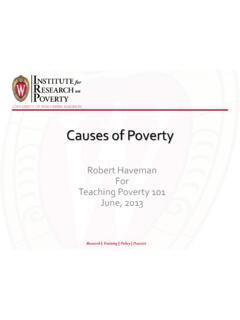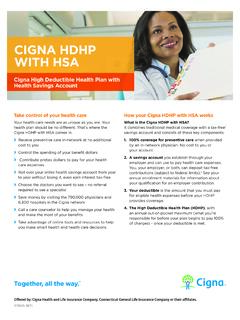Transcription of Changing the U.S. health care system: How difficult will ...
1 Changing the health care system: How difficult will it be? by Barbara L. Wolfe Barbara L. Wolfe is Professor of Economics and Preventive Medicine, University of Wisconsin-Madison, and an IRP affiliate. Issues of health care reform are gaining increasing attention and are now very high on the list of current public policy concerns in the United States. Two central problems face the health care system. One is the increasing cost of medical care ; the other is the lack of health insurance for growing numbers of citizens. Yet major change is unlikely in the near future. Why is this?
2 Problems of the health care system Costs The United States spends more money per capita on health care than any other country.' Furthermore, health care costs continue to increase at a high rate: in the last decade, every 40 months the share of the Gross National Product (GNP) spent on health care went up by 1 percent. It was percent in 1990 and, according to some experts, is expected to be 14 percent this fiscal year.' Even if the rate of increase remained constant, by the year 2000 the United States would be spending at least 15 percent of its GNP on health care . Most of the costs for health care are paid by so-called third parties-private insurers, public insurance, public direct provision.
3 Only about 25 percent of the costs are paid directly by consumers. The dominant form of health insurance in the United States is private insurance. Approximately three-quarters of citizens are covered by private plans (two-thirds of these are covered by employer-based plans); 18 percent are cov- ered by public plans (Medicaid and Medicare), and percent have no ~overage.~ Many people-particularly the elderly-are covered by both private and public plans. About percent of the population, including more than 15 percent of all children, are covered by Medicaid: a joint federal-state public program that pays for the health care of low-income and disabled citizens.
4 The greatest outlay of Medicaid funds, however, goes to the elderly. In 1990, 27 percent of total Medicaid spending was for nursing home care (excluding care for the mentally ret~ded).~ The largest public program to provide health insurance is Medicare, a federal program providing coverage to those 65 and over and the disabled who qualify to receive Social Se~urity.~ For businesses, the cost of health care is escalating rapidly, more rapidly than inflation and their profits from increased productivity combined. This situation limits a firm's : hility to shift the increase in premium costs to employees.
5 ' In- stead, businesses are offering less generous plans: They are increasing deductibles and/or the co-insurance rate and, more important, they are reducing coverage of the depen- dents of workers. Coverage for part-time employees has been cut, as have benefits for temporary employees. One aspect of health care costs that has become increas- ingly important to firms is the liability to pay for health care benefits promised to retirees. Beginning this year, firms have to report on their financial statements the unfunded liability of health insurance benefits promised- the estimated amount they owe their retirees in health ben- efits.
6 One early estimate is a $227 billion liability in 1988 dollar^.^ health care expenditures are also an increasing problem for the public sector. Medicaid continues to grow as a share of state budgets, reflecting both price increases and increases in benefits and eligibility mandated by the federal govern- ment. Similarly, health care spending is a major problem for the federal government-it is the second fastest grow- ing component of the federal budget (outpaced only by the growth in the public debt). At both levels of government, health care spending accounts for at least 14 percent of total expenditure^.
7 ^ These costs create fiscal pressures on the governments and limit their ability to respond to other needs, including reducing their budget deficits. The uninsured The other major aspect of the health care dilemma is the increasing numbers of persons without health insurance. This problem has grown as firms have cut back on private coverage, as persons have become unemployed, as increas- ing numbers have taken jobs in industries that tend not to provide coverage (such as the service sector), and as states have attempted to reduce their Medicaid expenditures by restricting eligibility for Medicaid (and welfare).
8 Approxi- mately million citizens do not have any health insurance coverage,I0 and millions more have too little health insurance to cover the costs of catastrophic illnesses or serious injuries. The probability of being uninsured is far greater among persons who live in families with incomes below the pov- erty line or just above it compared to those who live in families with higher incomes. Young persons are much more likely to be uninsured than older persons, and those living in single-parent households are less likely to be protected than childless couples. Strong evidence exists of a link between insurance cover- age and utilization of medical care .
9 " Those with insurance use more care , controlling for health , age, and location, than those without coverage; those with more extensive coverage use more care (at least outpatient care ) than those with limited coverage. The lack of coverage causes finan- cial insecurity, inequitable burdens across communities, increased costs for businesses (which must pay higher pre- miums to cover the costs to medical facilities of care for uninsured and underinsured persons), and increased partici- pation in welfare programs such as Aid to Families with Dependent Children, in addition to delayed and forgone medical care .
10 Proposed alternative health care plans Many economists, policy analysts, and politicians have proposed alternative health care plans. These plans can be classified into four categories: employer mandates, expan- sion of current arrangements, tax incentives, and national- ized health insurance. The employer mandate, the so-called pay-or-play plan, requires employers to provide some mini- mum level of coverage to all employees and their depen- dents. Employers could either provide insurance to em- ployees directly, following set specifications both on the breadth and depth of insurance coverage and the "propor- tion of the premium paid for by the employer,"12 or they could pay a fixed percentage of their payroll (or a fixed percentage up to a maximum per employee) into a pool, the funds from which would cover the cost of insurance for their employees and their dependents.



